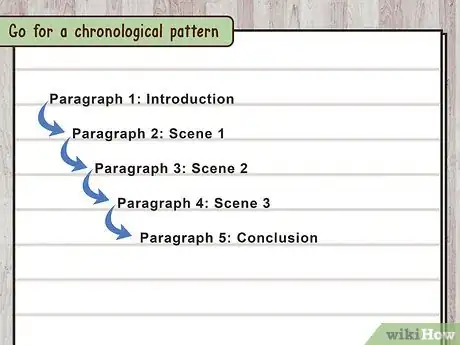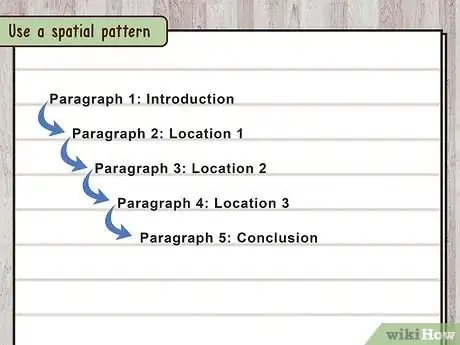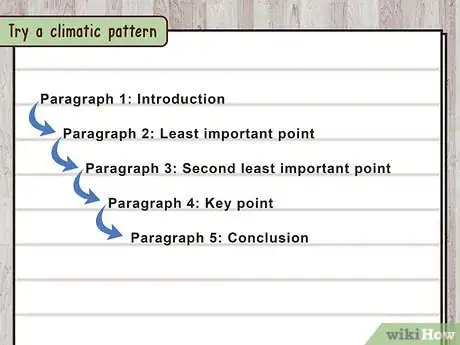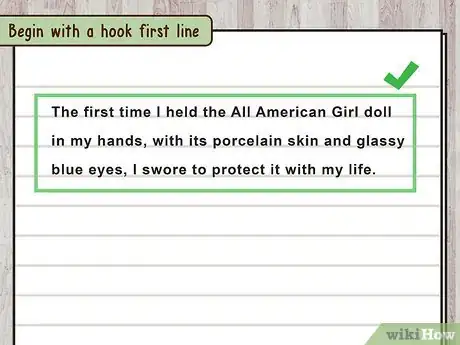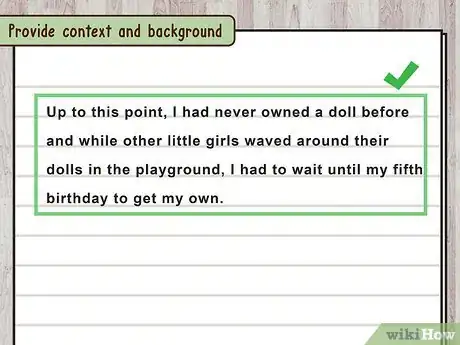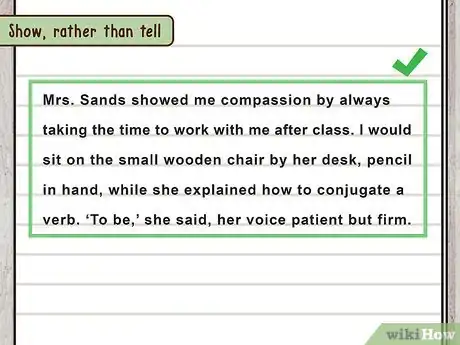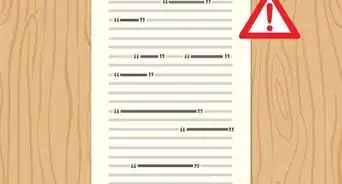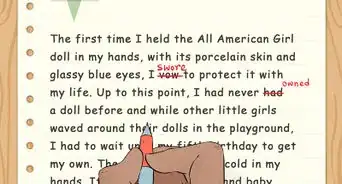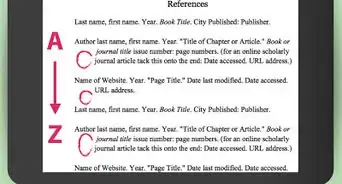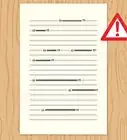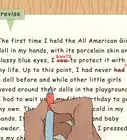This article was co-authored by Jake Adams. Jake Adams is an academic tutor and the owner of Simplifi EDU, a Santa Monica, California based online tutoring business offering learning resources and online tutors for academic subjects K-College, SAT & ACT prep, and college admissions applications. With over 14 years of professional tutoring experience, Jake is dedicated to providing his clients the very best online tutoring experience and access to a network of excellent undergraduate and graduate-level tutors from top colleges all over the nation. Jake holds a BS in International Business and Marketing from Pepperdine University.
This article has been viewed 89,497 times.
A descriptive essay should give the reader a clear image of a person, object, place, or event. The essay should have good descriptions and vivid sensory details. You may need to write a descriptive essay for a class or decide to try out the form for fun. To start a descriptive essay, begin by brainstorming topics and outlining the essay.[1] Then, create a strong opening for the essay so your reader is drawn into the narrative.
Steps
Brainstorming Topics for the Essay
-
1Choose a person to describe. One possible topic for a descriptive essay is a person that you feel strongly about, such as a mentor, a friend, a parent, or a role model. The person may be someone very close to you who knew you during a formative period in your life, such as your mother. Or the person could be someone you do not know well who has qualities you admire or wish to emulate, such as your favorite basketball player.[2]
- If you are writing the descriptive essay for a college application, you may choose a person who is a role model or a mentor to you. Describing this person in the essay will give you the chance to discuss why this person is important to you and the lessons you have learned from this person.
-
2Describe an object. Another possible topic option for a descriptive essay is an object that has meaning or significance to you. The object could be from childhood or adolescence. It could be your favorite object as a kid or the object you hated the most. Maybe the object has sentimental value or holds deep meaning for you.[3]
- For example, you may choose your favorite childhood toy as the topic for the essay. You could then describe the toy and what it meant to you growing up.
Advertisement -
3Select a place to describe. Identify a place that is important to you and describe it in your essay. The place could be your hometown, your bedroom, or your favorite spot at school. You could also choose the ideal place, or where you would go if you could go anywhere in the world.[4]
- For example, you may choose the most beautiful place you have ever been to. You can then describe the experience of the place and how it made you feel.
-
4Pick an event or memory to describe. Choose a significant event in your life and use it as the topic of your essay. The event could have happened recently or very far back in the past. Pick an event that taught you something or shifted your world view.[5]
- For example, you may choose the first time you got your period or the first time you visited a relative in the hospital.
Outlining the Essay
-
1Go for a chronological pattern. One option for outlining a descriptive essay is to use a chronological pattern, where you move in the order of time. The writing will move from scene to scene, describing events or moments as they happened. This is a good outlining option if you are writing about an event or memory in your descriptive essay. The outline will look like:[6]
- Paragraph 1: Introduction
- Paragraph 2: Scene 1
- Paragraph 3: Scene 2
- Paragraph 4: Scene 3
- Paragraph 5: Conclusion
- You can use five paragraphs for this outline or have more than one paragraph for each scene.
-
2Use a spatial pattern. A spatial pattern follows the order of space, where you break the essay down by location. The writing will move like a film camera, providing details in each location. This is a good option if you are writing about a place in your descriptive essay. The outline will look like:[7]
- Paragraph 1: Introduction
- Paragraph 2: Location 1
- Paragraph 3: Location 2
- Paragraph 4: Location 3
- Paragraph 5: Conclusion
-
3Try a climatic pattern. A climatic pattern follows the order of importance, where items are organized from less important to more important. This will allow you to save the most important point or climatic moment for the end of the essay. You can use this outline for most topics, from a person to an object to a place or an event. The outline will look like:[8]
- Paragraph 1: Introduction
- Paragraph 2: Least important point or detail
- Paragraph 3: Second least important point or detail
- Paragraph 4: Key point or detail
- Paragraph 5: Conclusion
-
4Create a thesis statement.[9] No matter what outline or pattern you choose for the descriptive essay, you should still have a thesis statement. The thesis statement should appear in the introduction and the conclusion of the essay. A strong thesis statement will state the key idea or theme in your essay. It will serve as a guide or map for the rest of the essay.[10]
- For example, if you are writing about a person who is your role model in the essay, your thesis statement may be, “Based on her actions that day in my 6th grade classroom, she taught me how to rise above negativity and be confident in my abilities as an artist.”
Creating a Strong Opening for the Essay
-
1Begin with a hook first line. Draw your reader in by starting with a first line that will grab the reader's attention right away.[11] The first line could start in scene with a strong description of an event, place, object, or person. You could also describe the first time you experienced an event, place, object, or person. Take the reader straight into the experience so they feel immersed and engaged.[12]
- For example, you may describe the first time you held an important object, “The first time I held the All American Girl doll in my hands, with its porcelain skin and glassy blue eyes, I swore to protect it with my life.”
-
2Provide context and background. Situate the reader by providing brief background on the topic. Give the reader just enough information to understand the significance of the object, place, event, or memory you are writing about in the essay. The context should ground the reader in the essay.[13]
- For example, you may briefly explain why the object was so significant to you based on your experience or knowledge at the time. You may write, “Up to this point, I had never owned a doll before and while other little girls waved around their dolls in the playground, I had to wait until my fifth birthday to get my own.”
-
3Use sensory details. A key element of a good descriptive essay is a lot of details that focus on the five senses: smell, taste, touch, sight, and sound. Put a lot of sensory details into your opening paragraph. Describe how a scene sounds or tastes. Discuss how an object feels or smells. Explore how a place sounds and looks.
- For example, rather than write “The doll was pretty,” you may write with sensory detail. “The doll felt soft and cold in my hands. It smelled like flowers and baby powder. It sounded hollow when I pressed it to my chest.”
-
4Show, rather than tell. To write a good opening for your essay, focus on showing your reader a scene, rather than telling them the scene. Avoid reporting on the events as they happened or just the action of a scene. Instead, use sensory detail and vivid descriptions to place the reader in a place, an event, a moment, or a memory.[14]
- For example, you may describe how it feels to be in your childhood home by writing, “The best memories in my childhood home appear on the walls, dents, scratches, and markings made by my siblings and I when we wrestled or ran around inside.”
- If you are writing about a person, use examples of their behavior to show the reader their character, rather than simply tell the reader what to think.
- For example, you may write, “Mrs. Sands showed me compassion by always taking the time to work with me after class. I would sit on the small wooden chair by her desk, pencil in hand, while she explained how to conjugate a verb. 'To be,' she said, her voice patient but firm.”
Expert Q&A
Did you know you can get expert answers for this article?
Unlock expert answers by supporting wikiHow
-
QuestionHow much time should I give myself to write a strong essay?
 Jake AdamsJake Adams is an academic tutor and the owner of Simplifi EDU, a Santa Monica, California based online tutoring business offering learning resources and online tutors for academic subjects K-College, SAT & ACT prep, and college admissions applications. With over 14 years of professional tutoring experience, Jake is dedicated to providing his clients the very best online tutoring experience and access to a network of excellent undergraduate and graduate-level tutors from top colleges all over the nation. Jake holds a BS in International Business and Marketing from Pepperdine University.
Jake AdamsJake Adams is an academic tutor and the owner of Simplifi EDU, a Santa Monica, California based online tutoring business offering learning resources and online tutors for academic subjects K-College, SAT & ACT prep, and college admissions applications. With over 14 years of professional tutoring experience, Jake is dedicated to providing his clients the very best online tutoring experience and access to a network of excellent undergraduate and graduate-level tutors from top colleges all over the nation. Jake holds a BS in International Business and Marketing from Pepperdine University.
Academic Tutor & Test Prep Specialist
-
QuestionHow can I write a descriptive essay for a portrait or drawing?
 PhantasmagoriaCommunity AnswerStart by deciding what your goal for the essay is. The portrait or drawing should be something that you can say enough about, without becoming repetitive. If your subject is suitable, then come up with an outline for what you plan to describe. If it's a portrait, consider the person's features, the colors used, their outfit, the background, the style of the art, etc. Figure out what order you plan to describe things in, then write the essay following that outline.
PhantasmagoriaCommunity AnswerStart by deciding what your goal for the essay is. The portrait or drawing should be something that you can say enough about, without becoming repetitive. If your subject is suitable, then come up with an outline for what you plan to describe. If it's a portrait, consider the person's features, the colors used, their outfit, the background, the style of the art, etc. Figure out what order you plan to describe things in, then write the essay following that outline. -
QuestionHow can I write a descriptive essay about special people in my life?
 Community AnswerLet the reader know that the person is special, not just by describing the way they look and act, it needs to also talk about the way they make you feel. Explain what types of emotions they make you feel and be sure to not only explain what you see, but how they talk and smell, etc. You can use metaphors and similes if you wish and if you have trouble thinking of descriptive words, you can search for synonyms in the internet (e.g. "happy synonyms”). Don’t try to force the descriptive writing out, but imagine seeing the person now and if it helps, try writing down as many things about them as you can and use that as a base for your essay!
Community AnswerLet the reader know that the person is special, not just by describing the way they look and act, it needs to also talk about the way they make you feel. Explain what types of emotions they make you feel and be sure to not only explain what you see, but how they talk and smell, etc. You can use metaphors and similes if you wish and if you have trouble thinking of descriptive words, you can search for synonyms in the internet (e.g. "happy synonyms”). Don’t try to force the descriptive writing out, but imagine seeing the person now and if it helps, try writing down as many things about them as you can and use that as a base for your essay!
References
- ↑ Jake Adams. Academic Tutor & Test Prep Specialist. Expert Interview. 20 May 2020.
- ↑ https://essaypro.com/blog/descriptive-essay/
- ↑ https://essaypro.com/blog/descriptive-essay/
- ↑ https://essaypro.com/blog/descriptive-essay/
- ↑ https://essaypro.com/blog/descriptive-essay/
- ↑ https://www.collegeessay.org/blog/descriptive-essay-writing/descriptive-essay-outline
- ↑ http://www.scoolwork.com/EssayWritingGuide/how_to_write_a_descriptive_essay_on_any_topic.aspx
- ↑ http://www.scoolwork.com/EssayWritingGuide/how_to_write_a_descriptive_essay_on_any_topic.aspx
- ↑ Jake Adams. Academic Tutor & Test Prep Specialist. Expert Interview. 20 May 2020.
- ↑ http://www.grammarcheck.net/how-to-write-a-descriptive-essay/
- ↑ Jake Adams. Academic Tutor & Test Prep Specialist. Expert Interview. 20 May 2020.
- ↑ http://www.scoolwork.com/EssayWritingGuide/how_to_write_a_descriptive_essay_on_any_topic.aspx
- ↑ http://www.scoolwork.com/EssayWritingGuide/how_to_write_a_descriptive_essay_on_any_topic.aspx
- ↑ https://www.butte.edu/departments/cas/tipsheets/style_purpose_strategy/descriptive_essay.html





